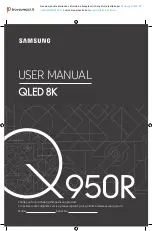
56
LC-32LE631
LC-40LE631
LC-46LE631
Description
Layer 1 Layer 2
Monitored
by
Error/
Prot
Error Buffer/
Blinking LED Device
Defective Board
I
2
C3
2
13
MIPS
E
BL / EB
SSB
SSB
I
2
C2
2
14
MIPS
E
BL / EB
SSB
SSB
I
2
C4
2
18
MIPS
E
BL / EB
SSB
SSB
PNX doesn’t boot (HW cause) 2
15
Stby μP
P
BL
PNX8550
SSB
12V
3
16
Stby μP
P
BL
/
Supply
Inverter or display supply
3
17
MIPS
E
EB
/
Supply
PNX51X0
2/9
21
MIPS
E
EB
PNX51X0
200 Hz board
HDMI mux
2
23
MIPS
E
EB
Sil9x87A
SSB
I2C switch
2
24
MIPS
E
EB
PCA9540
SSB
Channel dec DVB-S
2
28
MIPS
E
EB
STV0903
SSB
Lnb controller
2
31
MIPS
E
EB
LNBH23
SSB
Tuner
2
34
MIPS
E
EB
DTT 71300
SSB
Main nvm
2
35
MIPS
E
EB
STM24C64
SSB
Tuner DVB-S
2
36
MIPS
E
EB
STV6110
SSB
T° sensor SSB/set
2
42
MIPS
E
EB
LM 75
T° sensor
T° sensor LED driver/Tcon
7
42
MIPS
E
EB
LM 75
T° sensor
PNX doesn’t boot (SW cause) 2
53
Stby μP
P
BL
PNX8550
SSB
Display
5
64
MIPS
E
BL / EB
Altera
Display
5.5.3
How to Clear the Error Buffer
Use one of the following methods:
•
By activation of the “RESET ERROR BUFFER” command
in the SAM menu.
•
If the content of the error buffer has not changed for 50+
hours, it resets automatically.
5.5.4
Error Buffer
In case of non-intermittent faults, clear the error buffer before
starting to repair (
before
clearing the buffer, write down the
Table 5-2 Error code overview
content, as this history can give significant information). This to
ensure that old error codes are no longer present.
If possible, check the entire contents of the error buffer. In
some situations, an error code is only the result of another error
code and not the actual cause (e.g. a fault in the protection
detection circuitry can also lead to a protection).
There are several mechanisms of error detection:
•
Via error bits in the status registers of ICs.
•
Via polling on I/O pins going to the stand-by processor.
•
Via sensing of analog values on the stand-by processor or
the PNX8550.
•
Via a “not acknowledge” of an I
2
C communication.
Take notice that some errors need several minutes before they
start blinking or before they will be logged. So in case of
problems wait 2 minutes from start-up onwards, and then
check if the front LED is blinking or if an error is logged.
•
Via the blinking LED procedure. See section
5.5.3 How to
Clear the Error Buffer
.
Other root causes for this error can be due to hardware
problems regarding the DDR’s and the bootscript reading
from the PNX8550.
•
Error 16 (12V)
. This voltage is made in the power supply
and results in protection (LAYER 1 error = 3) in case of
absence. When SDM is activated we see blinking LED
LAYER 2 error = 16.
•
Error 17 (Invertor or Display Supply)
. Here the status of
the “Power OK” is checked by software, no protection will
occur during failure of the invertor or display supply (no
picture), only error logging. LED blinking of LAYER 1
error = 3 in CSM, in SDM this gives LAYER 2 error = 17.
•
Error 21 (PNX51X0)
. When there is no I
2
C communication
towards the PNX51X0 after start-up, LAYER 2 error = 21
will be logged and displayed via the blinking LED
procedure if SDM is switched on. This device is located on
the 200 Hz panel from the display.
•
Error 23 (HDMI)
. When there is no I
2
C communication
towards the HDMI mux after start-up, LAYER 2 error = 23
will be logged and displayed via the blinking LED
procedure if SDM is switched on.
•
Error 24 (I2C switch)
. When there is no I
2
C
communication towards the I
2
C switch, LAYER 2
error = 24 will be logged and displayed via the blinking LED
procedure when SDM is switched on. Remark: this only
works for TV sets with an I
2
C controlled screen included.
•
Error 28 (Channel dec DVB-S)
. When there is no I
2
C
communication towards the DVB-S channel decoder,
blinking LED procedure if SDM is switched on.
•
Error 18 (I
2
C bus 4, Tuner bus blocked)
. In case this bus
is blocked, short the “SDM” solder paths on the SSB during
startup, LAYER error 2 = 18 will be blinked.
•
Error 15 (PNX8550 doesn’t boot)
. Indicates that the main
processor was not able to read his bootscript. This error will
point to a hardware problem around the PNX8550
(supplies not OK, PNX 8550 completely dead, I
2
C link
between PNX and Stand-by Processor broken, etc...).
When error 15 occurs it is also possible that I
2
C1 bus is
blocked (NVM). I
2
C1 can be indicated in the schematics as
follows: SCL-UP-MIPS, SDA-UP-MIPS.
LAYER 2 error = 28 will be logged and displayed via the
Service Modes, Error Codes, and Fault Finding (continued)
Extra Info
•
Rebooting.
When a TV is constantly rebooting due to in-
ternal problems, most of the time no errors will be logged
or blinked. This rebooting can be recognized via a Hyper-
terminal (for Hyperterminal settings, see section “5.8 Fault
Finding and Repair Tips, 5.8.7 Logging). It’s shown that
the loggings which are generated by the main software
keep continuing.
•
Error 13 (I2C bus 3, SSB bus blocked).
Current situation:
when this error occurs, the TV will constantly reboot due
to the blocked bus.
•
Error 14 (I2C bus 2, TV set bus blocked).
Current situa-
tion: when this error occurs, the TV will constantly reboot
due to the blocked bus.
















































